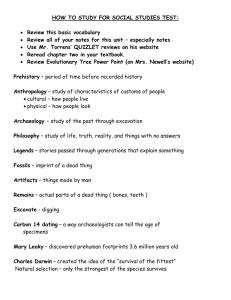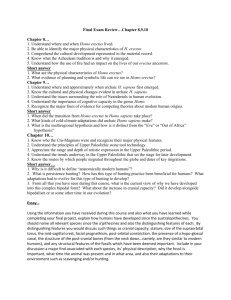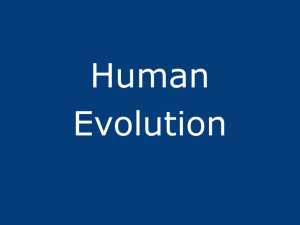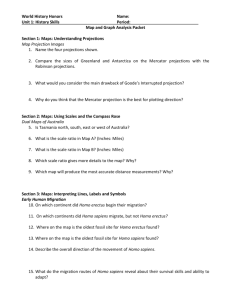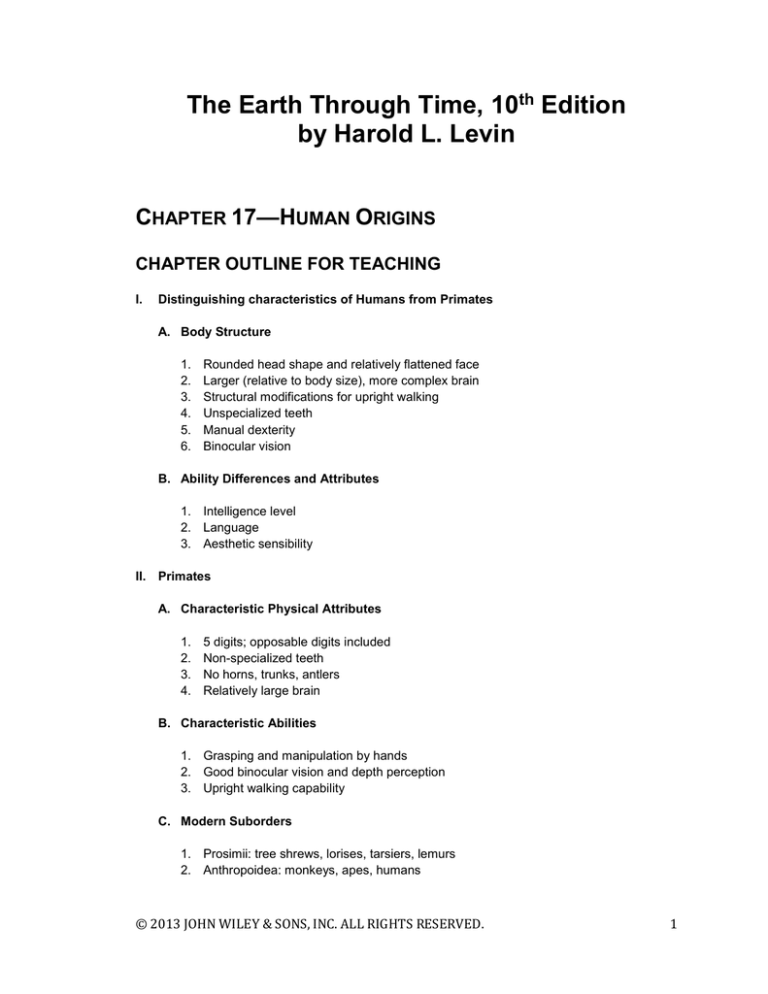
The Earth Through Time, 10th Edition
by Harold L. Levin
CHAPTER 17—HUMAN ORIGINS
CHAPTER OUTLINE FOR TEACHING
I.
Distinguishing characteristics of Humans from Primates
A. Body Structure
1.
2.
3.
4.
5.
6.
Rounded head shape and relatively flattened face
Larger (relative to body size), more complex brain
Structural modifications for upright walking
Unspecialized teeth
Manual dexterity
Binocular vision
B. Ability Differences and Attributes
1. Intelligence level
2. Language
3. Aesthetic sensibility
II. Primates
A. Characteristic Physical Attributes
1.
2.
3.
4.
5 digits; opposable digits included
Non-specialized teeth
No horns, trunks, antlers
Relatively large brain
B. Characteristic Abilities
1. Grasping and manipulation by hands
2. Good binocular vision and depth perception
3. Upright walking capability
C. Modern Suborders
1. Prosimii: tree shrews, lorises, tarsiers, lemurs
2. Anthropoidea: monkeys, apes, humans
© 2013 JOHN WILEY & SONS, INC. ALL RIGHTS RESERVED.
1
D. Prosimii Primitive Characteristics: claws, snouts
E. Anthropoidea Advanced Characteristics: flat faces, digits, vestigial or real tails
1. Ceboidea (New World monkeys): older branch; not human ancestors;
has prehensile tail (spider monkey, marmoset, capuchin)
2. Cercopithecoidea (Old World monkeys): younger branch; ancestors to
human lineage; no prehensile tail (macaque, rhesus monkey, Barbary
ape, langurs, baboons, mandrills)
3. Hominoidae: apes and humans
F. Families of Hominoidae
1. Hylobatidae (primitive branch): gibbons; siamangs
2. Pongidae (advanced branch)
a. arboreals: orangutan, chimpanzees
b. terrestrials: gorillas
3. Hominidae (hominins): African apes and humans
III. Evolutionary Step One: prosimian lineage
A. Cretaceous Purgatorius: Hell Creek Fm. (MT)
B. Paleocene Plesiadapis: U.S. and France; primitive tooth structure with gap
(diastema); claws on digits; extinct by late Eocene
C. Eocene Cantitus: Wyoming; shorter snout; grasping toe
D. Eocene Notharctus: Wyoming; replaced Cantitus
E. Eocene Tetonius: traits like a modern tarsier
F. General trends in Eocene evolution of prosimians
1. reduction in muzzle length
2. increase in brain size
3. shifting of eye orbits to more forward position
4. development of a grasping big toe
G. Oligocene cooling: forced prosimians out of North America to warmer latitudes
(Asia, Africa, southern Indies)
© 2013 JOHN WILEY & SONS, INC. ALL RIGHTS RESERVED.
2
IV. Evolutionary Step Two: early anthropoids
A. Oligocene Aegyptopithecus zeuxis: Egypt; robust arboreal primate; ape-like 5cusped molar with Y-shaped troughs between cusps; ape ancestor
B. Oligocene-Miocene New World monkeys: South America; independent evolution:
4-cusped molar-like all monkeys
C. Oligocene-Eocene Old World monkeys: Eurasia
D. Miocene plate tectonics and evolution: closing of Tethys led to cooling and
drying of east Africa; grasslands replaced forests; primate evolution thus affected
E. Miocene drymorphs: Dryopithecus fontani (France); Proconsul africanus
(Kenya); ape-like form
F. Middle Miocene Proconsul: ancestor to modern African apes and
australopithecine humans
G. Middle Miocene australopithecine: Equatorius
H. Middle Miocene ramamorph: Ramapithecus
I.
Late Miocene pongids (chimpanzee, gorilla, and orangutang)
J. Common ancestor of apes and hominins: the ramamorphs (Ramapithecus)
V. Evolutionary Step Three: australopithecines and hominins
A. Australopithecines: robust and gracile forms; upright walking; human stance;
robust teeth; brain size of apes (about 600 cm3); used crude tools
1. Chronology of genus Australopithecus
a. Sahelanthropus tchadensis: 7-6 million years ago
b. Orrorin tugenesis: 6 million years ago; Kenya
c. Ardipithecus ramidus: 5.8-5.2 million years ago; Ethiopia
d. Australopithecus anamensis: 4.2-3.9 million years ago; Kenya
e. Australopithecus afarensis (“Lucy”): 3.9-3.0 million years ago; eastern Africa
f. Australopithecus robustus and A. bosei: younger fossils
2. Transition to homonids: increased size of cranial vault; changed
position of foramen magnum; narrower premolars, length of tooth row
reduced; stone tools associated with fossils
a. Homo rudolfensis and H. habilis (a.k.a. H. ergaster): 2.5-2.0
m.y.; savannahs of Africa
b. Homo erectus: moved out of Africa into Asia
3. Reasons for australophithecine-homonid transition
a. Africa growing cooler and drier 2.7 million years ago
b. rain forest transition to grassland
c. selective pressures for bipedalism and cerebral abilities
© 2013 JOHN WILEY & SONS, INC. ALL RIGHTS RESERVED.
3
B. Hominins: emergent human with human-like teeth; larger brains; social, tool users
1. Beginning of the fossil record for primates: Sahelanthropus tchadensis (Chad; 4 ft tall;
6to 7 m.y. ago; mix of human and ape characteristics)
2. Another early hominin: Orrorin tungenensis (Kenya; 6 m.y. ago; human-like femur)
3. Possible transition species: Australopithecus sediba (South Africa; small brain, but
modern human-like hands)
VI. Evolutionary Step Four: Homo erectus (“first true humans”); first hominins to
move out of Africa
A. Chronology of Dispersion
1.
2.
3.
4.
Early Pleistocene (1.8 m.y.): H. erectus in Rep. of Georgia
Early Pleistocene (1.5 m.y.): H. erectus at west Turkana site (Africa)
Middle Pleistocene (0.9 m.y.): H. erectus known in Africa and Europe
Late Pleistocene (0.01 m.y.): H. erectus fully dispersed globally
B. Trends in Homo erectus Evolution during Pleistocene
1. Brain-size increase: 775 to 1300 cm 3
2. Pelvic changes to accommodate birth of larger babies’ head
C. Homo erectus Characteristics
1. Prognathous face: sloped forehead, broad flat nose, modern human
teeth; chinless
2. Hunters, tool makers, builders
3. Social units or bands
4. Cannibalism or slaughter sites (mass graves)
5. May have used fire in daily life
VII. Evolutionary Step Five: Homo sapiens
A. Homo sapiens neanderthalensis (Germany): late Pleistocene descendent of
Homo erectus; brow ridges; prognathous; chinless jaw; human-like below neck;
brain size 1200-1500 cm3 (= human today); “cave man”
1. Activities: cave-dwelling, painting, carving, tool making, rituals of
hunting, death rituals
2. Use of fire: heating, cooking, crafting
3. New DNA evidence suggests H. sapiens neanderthalensis may not be so closely
related to H. sapiens as previously thought
© 2013 JOHN WILEY & SONS, INC. ALL RIGHTS RESERVED.
4
B. Homo sapiens sapiens (Cro-Magnon man; northern Europe): replaced
Neanderthals in all regions 34,000 yr ago during last Pleistocene glacial stage;
possible Cro-Magnon-Neanderthal “war” or severe competition for resources.
1. Characteristics: vertical brow, projected chin, modern human teeth;
modern human skull; brain size 1200-1500 cm3; same cranial type as
found today in northern Europe, north Africa, and Canary Islands.
2. Transitional Neanderthal-Cro-Magnon forms: Palestine, South Africa,
Germany, Czech Republic
a. Neanderthal-Cro-Magnon evolution outside Europe
b. Cro-Magnon migration into Europe and Asia during slight
glacial retreat 35,000 yr ago
3. Activities: tool making, painting, rituals, hunting, engraving, sculpting,
burial ceremony, ornaments and clothing, cultivation of plants and
animals, tribal activities
4. Evidence of higher thought: complexity of rituals, tribal organization,
variety of tools and items created, intricate clothing, skill levels, language
and symbols
5. Migration of aboriginal people into North America
a. likely timing near end of last Pleistocene glaciation when sea
level was lower
b. enter across Bering Straits (land bridge between Asia and North America)
c. evidence of west coast and Alaska occupation: flints and
campfires 30,000 to 23,000 yr old
6. Paleo-Indians of late Pleistocene
a. Clovis and Sandia (NM) sites: tools dated at 11,000 and 13,000 yr
b. Folsom Culture: 9,000-11,000 yr ago
C. Homo floresiensis (little people of the southern Pacific)
VIII.
Human Population Growth
A. Change over Time
1. Estimate at end of Pleistocene (10,000 yr ago): 6 million humans
2. Current population: 7 billion
3. Projection for year 2050 A.D.: 9 billion humans
B. Depletion of Resources
1.
2.
3.
4.
5.
6.
7.
8.
20% topsoil now used up
33% forested areas lost in last 50 yr
12.5% agricultural land destroyed by overgrazing
Massive loss of soil productivity
5% reduction in ozone layer
33% increase in greenhouse gas since industrial revolution
Water shortages becoming common
Depletion of many key mineral resources
© 2013 JOHN WILEY & SONS, INC. ALL RIGHTS RESERVED.
5
C. Future Goals to Sustain Quality Life
1.
2.
3.
4.
Reduce population growth; stabilize world population
Reforestation and land conservation
Pollution reduction
Recycling of mineral and other resources
Answers to Discussion Questions
1. Hominoidea and hominidae are distinguished as superfamily and family, respectively, of
humans. Hominoidea includes three families (hylobatidae, pongidae, and homonidea).
Modern primates are divided into suborders Prosimii (includes tree shrews, lorises, and
tarsiers) and Anthropoidea (includes monkeys, apes, and humans). The hylobatidae and
pongidae are families within the super family hominoidea. Hylobatidae includes gibbons and
siamongs. Pongidae includes orangutans, chimpanzees, and gorillas. Ceboidea and
cercopithecoidea are two superfamilies that, along with hominoidea, make up the suborder
Anthropoida Ceboidea includes howler monkeys, spider monkeys, capuchin, common
marmosets, and pinche monkeys. Cercopithecoidea includes macaque, baboon, wanderloo,
common langur, and proboseis monkey.
2. The close-set eyes and grasping hands are anthropoid characteristics that allowed vision in
three dimensions and manipulation of objects with the hands (with feet).
3. The first robust arboreal primates were Aegyptopithecus, an Oligocene fossil. The fourlegged ancestral primate was Proconsul, a middle Miocene fossil. The first upright-walking,
two-legged primate was Ardipithecus ramidus, an early Pliocene fossil. The first specimens
of Homo are about 2.5 million years old (Pliocene).
4. Chert (and its variety flint) made excellent spear points, axes, and scrapers because those
materials break easily into sharp fragments which hold a sharp edge for a long time.
5. The lack of vegetation in the desert regions of eastern Africa combined with dateable
interlayered volcanic ash and lava flows make finding and dating fossils easier there.
Eastern Africa is a key site of long-term hominoid occupation, unlike other parts of the world.
6. Australopithecus’ human-like traits were pelvis and leg bones that indicate upright walking
and tooth structure (dentition). Their apelike characteristics were small stature, skull shape
(jaw thrust forward and no chin), and small cranial capacity (about 800 cm3).
7. Cro-Magnon people (Homo sapiens sapiens) were taller, had more vertical brow, projecting
chin, and changed tooth arrangement. They also perfected stone and bone tool
manufacture, produced carving, sculpture, and cave art, and developed ornaments to be
worn. These characteristics set them apart from Neanderthal people whom they displaced.
© 2013 JOHN WILEY & SONS, INC. ALL RIGHTS RESERVED.
6
8. The Paleocene Pleisadapis (prosimian) skull contains primitive teeth with a distinctive gap
(diastema) between incisors and cheek teeth. The overall skull shape was rodent-like, that is
tapered to a snout. During Eocene, prosimian snouts grew shorter (e.p.g., Cantitus and
Notharactus). During Oligocene, anthropoids like Aegyptopithecus (a robust arboreal
primate) developed 5-cusped molars and a snout-less, ape-like face. This facial type
characterizes Miocene forms like Dryopithecus and Proconsul. Pliocene Australopithecus
species showed larger brain capacities (600-700 cm3) robust teeth, brow ridges, prognathous
brow, and chinless jaw. Pleistocene Homo erectus and subsequent Homo sapiens
neanderthalensis had similar features of the skull but the brain capacity was 775 to 1300 cm 3
and 1200 to 1500 cm 3, respectively. Thus there was a progressive increase. Modern
humans, Homo sapiens sapiens developed a vertical brow, distinctive chin, and modern
cranial shape (volume = 1200-1500 cm3) approximately 34,000 yr ago.
9. Homo sapiens sapiens migrated into the New World (i.e., the Americas) via the Bering Strait
land bridge near the end of the last glacial cycle 12,000 to 18,000 yr ago. It makes most
sense to assume they migrated during a glacial maximum when the most dry land would
have been exposed on the shelf area of the Bering Strait. The Bering connection is the only
possible Asian-American connection. Radiocarbon dates of most ancient human-fossil sites
in western North America cluster about this time (12,000-18,000 yr). A brief warm spell
during a glacial interval would be best so that long-distance migration would be easier
physically. However, a full interglacial warming would likely have raised sea level to the
height where the land bridge was flooded.
10. Life will potentially be more difficult for people in the year 2050 if population trends are left
unchecked. Degradation trends in topsoil quality and quantity, forested areas, grazing tracts,
ozone chemistry, greenhouse gas balance, water quality and quantity and key mineral
resource availability all spell trouble for the future. If global goals of curtailing population
growth, reforestation, land conservation, pollution reduction, and resource recycling can
come about, the year 2050 may not seem so bleak as technological advance may catch up to
help us affect solutions to adequately support a large but stable global population well above
current levels.
11. The area experienced numerous volcanic eruptions during this interval of geological history
and the ash falls from these eruptions mixed with water make excellent material to preserve
fossil remains and imprints of human footprints. The volcanic ash is very each to date
radiometrically and this provides excellent age control for these fossil finds.
12. c
13. b
14. e
© 2013 JOHN WILEY & SONS, INC. ALL RIGHTS RESERVED.
7
Chapter Activities
Student activities for in-depth learning.
1. According to this February, 2009, New York Times article (http://www.nytimes.com/
2009/02/13/science/13neanderthal.html), what have recent studies of the Neanderthal genome
suggested to scientists about the nature and abilities of this early human form?
2.
According
to
this
National
Geographic
Society
2009
news
article
(http://news.nationalgeographic.com/news/2009/02/090226-oldest-footprints.html), what has the
discovery of these oldest human footprints in Africa told us about the abilities of humans and their
life style of 1.5 million years ago?
© 2013 JOHN WILEY & SONS, INC. ALL RIGHTS RESERVED.
8





